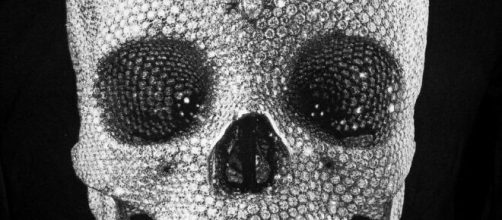Some people will do anything for attention.
But when the attention-getter is already in the limelight for the last two decades for outselling all other artists, you don’t expect him to lie about selling work for $100 million when it didn’t sell at all?
In 2007 Reuters reported that an anonymous consortium paid Damien Hirst the most ever paid for an artwork in all of history for a skull of an 18th century 35-year-old that Hirst studded with diamonds.
No joke
And because the skull is believed to be that of a monk, Hirst titled it "For the Love or God." It’s not even his original idea.
He borrowed the idea from artist John LeKay’s skull covered with crystals created in 1993.
More than 8,600 diamonds – about 1,000 carats worth – encrust the skull, reportedly costing Hirst $15 million to produce. If you’re wondering what the point of it is, it helps to remember that Hirst likes to make headlines.
As far as I can tell, there is no point other than that. Equally pointless was Hirst’s first work that made him famous in the first place – the one in which he diced and pickled animals – a shark, a sheep, and a cow – and displayed them in formaldehyde.
That barbarism won him the Turner Prize in 1992 and a ton of headlines.
What happened to us?
Art has been a civilizing force for centuries, giving meaning to life besides procreating.
Since the Renaissance, artists have loaded their work up with emotive gestures portraying our sentient selves in dimensional ways.
But today, we live in a world where a skull studded with gems makes headlines, making savages of us all. That it turns out no one bought the skull doesn’t matter. The press reporting Hirst’s lie misses the point.
The point is that a human skull with jewels sticking out of it is classed as art and taken seriously. The attention, even praise, heaped on this thing catapults us back to the barbarism of our Neanderthal days. And it has had an effect on the art world.
Hirst’s fellow artist Tracy Emin said he inspired her to make art “in a whole new way.” Her admiration gave rise to "My Bed," for which she received a Turner Prize nomination.
"My Bed" is Emin’s real-life sack littered with the detritus s of a failed love life – drained whiskey bottles, cigarette smoked down to stubs all scattered over semen and menstrual blood-stained bed sheet.
Heaping praise
More lauding for Hirst came from Blake Gopnik, former chief art critic for the Washington Post. He placed him on a list of the ten most important artists in 2011. He called him “a metaphor for how consumption has become our guiding force.”
Is that what we’ve become? When did we stop reaching for more? To be fair, even in the Renaissance, Leonardo Da Vinci complained that artists didn’t reach high enough. As he wrote, “In spite of all the paint being splashed about... In general, our portraiture is flat and expressionless.”
One can guess what he’d say about Hirst’s diamond skull.
It doesn’t matter that some art critics have panned Hirst’s even in his native land. It doesn’t matter that British critic Robert Hughes wrote in The Guardian that Hirst is “tacky and absurd,” and Tom Lubbock wrote in the Independent that his work is “derivative, weak and boring.”
The press still elevates him with its headlines. Goethe, Germany’s great cultural force, should get a mention here. He said that if you haven’t seen the Sistine Chapel, you can’t know what the human being is capable of.
I’m not asking for a Michelangelo picture of us, only an honest one that reaches past sensation.


